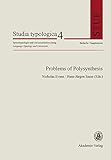Problems of Polysynthesis / hrsg. von Nicholas Evans, Hans-Jürgen Sasse.
Material type: TextSeries: Studia Typologica [STTYP] : Beihefte / Supplements STUF - Sprachtypologie und Universalienforschung / Language Typology and Universals ; 4Publisher: Berlin : Akademie Verlag, [2014]Copyright date: ©2002Description: 1 online resource (280 p.)Content type:
TextSeries: Studia Typologica [STTYP] : Beihefte / Supplements STUF - Sprachtypologie und Universalienforschung / Language Typology and Universals ; 4Publisher: Berlin : Akademie Verlag, [2014]Copyright date: ©2002Description: 1 online resource (280 p.)Content type: - 9783050037325
- 9783050080956
- 612.82336 23
- P291 .P763 2002eb
- online - DeGruyter
- Issued also in print.
| Item type | Current library | Call number | URL | Status | Notes | Barcode | |
|---|---|---|---|---|---|---|---|
 eBook
eBook
|
Biblioteca "Angelicum" Pont. Univ. S.Tommaso d'Aquino Nuvola online | online - DeGruyter (Browse shelf(Opens below)) | Online access | Not for loan (Accesso limitato) | Accesso per gli utenti autorizzati / Access for authorized users | (dgr)9783050080956 |
Frontmatter -- Contents -- Introduction: problems of polysynthesis -- The true status of grammatical object affixes: evidence from Bininj Gun-wok -- How referential is agreement? The interpretation of polysynthetic dis-agreement morphology in Ngalakgan -- Syntax and morphology of polysynthesis in the Georgian verb -- Compound nouns vs. incorporation in Classical Nahuatl -- Dependent-head synthesis in Nivkh - with an outlook on polysynthesis in the -- Clause combining in Apache -- Infinitives in Polysynthesis: the case of Rembarrnga -- Lexicological and lexicographic problems of word families in Cayuga -- Ket as a polysynthetic language, with special reference to complex verbs -- The rise and fall of polysynthesis in the Eskimo-Aleut family -- Contributors
restricted access online access with authorization star
http://purl.org/coar/access_right/c_16ec
The papers deal with a range of questions raised for linguistic theory and description by polysynthetic languages. Prototypical polysynthetic lamguages, found among unrelated language families in such varied parts of the world as North America, Meso-America, Siberia, northern Australia, and Papua New Guinea, display remarkably similar suites of grammatical characteristics. But, nearly two centuries after Humboldt and Kleinschmidt began to make the existence and interest of polysythetic languages widely known among linguistics, languages of this type continue to pose a challange to every major linguistic theory.
Issued also in print.
Mode of access: Internet via World Wide Web.
In German.
Description based on online resource; title from PDF title page (publisher's Web site, viewed 28. Feb 2023)


